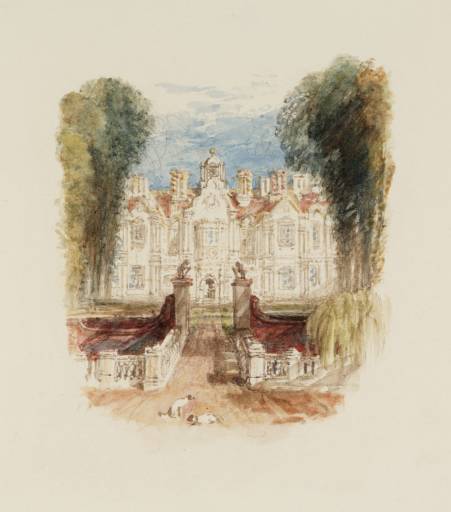Joseph Mallord William Turner An Old Manor-House, for Rogers's 'Poems' c.1830-2
Joseph Mallord William Turner,
An Old Manor-House, for Rogers's 'Poems'
c.1830-2
Joseph Mallord William Turner 1775–1851
An Old Manor-House, for Rogers’s ‘Poems’ circa 1830–2
D27718
Turner Bequest CCLXXX 201
Turner Bequest CCLXXX 201
Pencil and watercolour, approximately 110 x 98 mm on white wove paper, 259 x 219 mm
Stamped in black ‘CCLXXX 201’ bottom right
Stamped in black ‘CCLXXX 201’ bottom right
Accepted by the nation as part of the Turner Bequest 1856
Exhibition history
1904
National Gallery, London, various dates to at least 1904 (399).
1937
Display of Watercolours from the Turner Bequest, [Loan Series A and C], Towner Art Gallery, Eastbourne, January–March 1937 (no catalogue but numbered 8).
1946
Loan of Turner Watercolours from the Turner Bequest, [Loan Series A and C], Graves Art Gallery, Sheffield, September 1946–February 1947 (no catalogue but numbered 8).
1953
J.M.W. Turner R.A. 1775–1851: Pictures from Public and Private Collections in Great Britain, Whitechapel Art Gallery, London, February–March 1953 (172).
1975
Turner in the British Museum: Drawings and Watercolours, British Museum, London, May 1975–February 1976 (180, reproduced).
1993
Turner’s Vignettes, Tate Gallery, London, September 1993–February 1994 (15, reproduced).
References
1903
E.T. Cook and Alexander Wedderburn (eds.), Library Edition: The Works of John Ruskin: Volume I: Early Prose Writings 1834–1843, London 1903, pp.233, 244.
1904
E.T. Cook and Alexander Wedderburn (eds.), Library Edition: The Works of John Ruskin: Volume XIII: Turner: The Harbours of England; Catalogues and Notes, London 1904, pp.380–1.
1906
E.T. Cook and Alexander Wedderburn (eds.), Library Edition: The Works of John Ruskin: Volume XXI: The Ruskin Art Collection at Oxford, London 1906, p.214.
1909
A.J. Finberg, A Complete Inventory of the Drawings in the Turner Bequest, London 1909, vol.II, p.904, as ‘The English manor house’.
1953
Bryan Robertson and Sir John Rothenstein, J.M.W. Turner R.A. 1775–1851: An Exhibition of Pictures from Public and Private Collections in Great Britain, exhibition catalogue, Whitechapel Art Gallery, London 1953, p.26 no.172.
1966
Adele Holcomb, ‘J.M.W. Turner’s Illustrations to the Poets’, unpublished Ph.D thesis, University of California, Los Angeles 1966, p.81, as ‘Llewellyn Hall’.
1975
Andrew Wilton, Turner in the British Museum: Drawings and Watercolours, exhibition catalogue, British Museum, London 1975, pp.12, 20, 113 no.180, reproduced.
1979
Andrew Wilton, The Life and Work of J.M.W. Turner, Fribourg 1979, p.441 no.1184, reproduced.
1993
Jan Piggott, Turner’s Vignettes, exhibition catalogue, Tate Gallery, London 1993, pp.83 no.15 reproduced, 97.
The lark has sung his carol in the sky;
The bees have hummed their noon-tide lullaby.
Still in the vale the village-bells ring round,
Still in Llewellyn-hall the jests resound:
For now the caudle-cup is circling there,
Now, glad at heart, the gossips breathe their prayer,
And, crowding, stop the cradle to admire
The babe, the sleeping image of his sire.
(Poems, pp.63–4)
The bees have hummed their noon-tide lullaby.
Still in the vale the village-bells ring round,
Still in Llewellyn-hall the jests resound:
For now the caudle-cup is circling there,
Now, glad at heart, the gossips breathe their prayer,
And, crowding, stop the cradle to admire
The babe, the sleeping image of his sire.
(Poems, pp.63–4)
The vignette shows the eponymous manor house from the front, framed by tall trees and a grand entrance. Ruskin suggested that Turner designed the building after a drawing recorded in the Smaller Fonthill sketchbook of 1799–1802 (see Tate D02241; Turner Bequest XLVIII 6).3 However, it seems more likely that the house is simply an invention of the artist’s imagination. Jan Piggott has observed it also bears a strong resemblance to the house in another vignette illustration, Summer Eve – The Rainbow circa 1835 (National Gallery of Scotland) which Turner designed for The Poetical Works of Thomas Campbell (1837).4 It may be that the artist intended the structure in the later Campbell vignette as an allusion to the one seen here.5 Turner produced one study for the vignette (see Tate D27532; Turner Bequest CCLXXX 15). Jan Piggott has noted the resemblance of the Tudor style house in the study to East Barsham Manor, Norfolk.6
Turner’s meticulous attention to detail can be seen in the touched proofs of the engraved version of the design. On one such print (Yale Center for British Art),7 he instructed the engraver, William Miller to soften the sky and to add two steps beneath the doorway, whilst on another (University College London) he wrote: ‘This pediment too dark and nearest the 3 to look rich of ornament the marking of this Wing all too strong more like the right Wing the centre [?to] kept light’.8
Verso:
Inscribed by unknown hands in pencil ‘15’ upper centre and ‘30 | b’ upper centre and ‘CCLXXX.201’ bottom centre
Stamped in black ‘CCLXXX 201’ lower centre
Stamped in black ‘CCLXXX 201’ lower centre
Meredith Gamer
August 2006
How to cite
Meredith Gamer, ‘An Old Manor-House, for Rogers’s ‘Poems’ c.1830–2 by Joseph Mallord William Turner’, catalogue entry, August 2006, in David Blayney Brown (ed.), J.M.W. Turner: Sketchbooks, Drawings and Watercolours, Tate Research Publication, December 2012, https://www

